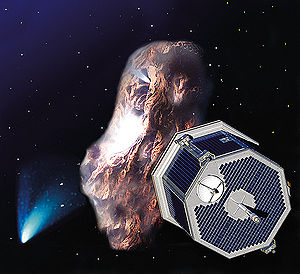
Back КОНТУР Bulgarian CONTOUR Catalan CONTOUR Czech CONTOUR German CONTOUR Spanish COmet Nucleus TOUR Finnish CONTOUR French CONTOUR Galician CONTOUR Hungarian CONTOUR ID
 Artist impression of CONTOUR approaching a comet. | |
| Mission type | Flyby (2P/Encke · 73P/Schwassmann–Wachmann · 6P/d'Arrest) |
|---|---|
| Operator | NASA · Applied Physics Laboratory |
| COSPAR ID | 2002-034A |
| SATCAT no. | 27457 |
| Mission duration | 1 month, 12 days |
| Spacecraft properties | |
| Launch mass | 328 kg (723 lb) |
| Start of mission | |
| Launch date | July 3, 2002 06:47:41 UTC (21 years, 10 months and 27 days ago) |
| Rocket | Delta II |
| Launch site | Cape Canaveral SLC-17 |
| Contractor | Boeing |
| End of mission | |
| Last contact | August 15, 2002 (21 years, 9 months and 15 days ago) |
The Comet Nucleus Tour (CONTOUR) was a NASA Discovery-class space probe that failed shortly after its July 2002 launch. It was the only Discovery mission to fail.
The two comets scheduled to be visited were Encke and Schwassmann-Wachmann-3, and the third target was d'Arrest. It was hoped that a new comet would have been discovered in the inner Solar System between 2006 and 2008, in which case the spacecraft trajectory would have been changed if possible to rendezvous with the new comet. Scientific objectives included imaging the nuclei at resolutions of up to 4 meters (13 ft), performing spectral mapping of the nuclei at resolutions of up to 100 meters (330 ft), and obtaining detailed compositional data on gas and dust in the near-nucleus environment, with the goal of improving knowledge of the characteristics of comet nuclei.
After the solid rocket motor intended to inject the spacecraft into solar orbit was ignited on August 15, 2002, contact with the probe could not be re-established. Ground-based telescopes later found three objects along the course of the satellite, leading to the speculation that it had disintegrated. Attempts to contact the probe were ended on December 20, 2002. The probe thus accomplished none of its primary scientific objectives, but did prove some spaceflight technologies, such as the APL-developed non-coherent Doppler tracking spacecraft navigation technique, which was later used on the New Horizons spacecraft.[1][2]
- ^ DeBoy, C.C.; Haskins, C.B.; Brown, T.A.; Schulze, R.C.; Bernacik, M.A.; Jensen, J.R.; Millard, W.; Duven, D.; Hill, S. (2004). "The RF telecommunications system for the New Horizons mission to Pluto". 2004 IEEE Aerospace Conference Proceedings (IEEE Cat. No.04TH8720). IEEE. pp. 1463–1478. doi:10.1109/aero.2004.1367922. ISBN 978-0780381551. S2CID 1979067.
- ^ The RF telecommunications system for the New Horizons mission to Pluto IEEEAC paper #1369, Version 4, Updated December 22, 2003
© MMXXIII Rich X Search. We shall prevail. All rights reserved. Rich X Search